- Messages
- 203
- Reactions
- 832
Case Prep
-----------------------------------------------------
The first step is lubing, and we use Castor Oil. Yeah, I inow. There are many hundreds of threads and thousands of posts all over the net about "the" best lube. Want to waste your money? Go for it. None of them beat Castor Oil. Its cheap and takes no more than 3 drops to do 100 cases. We line a shallow baking pan with foil, a few drops of Castor Oil, roll them around a couple of times and that's it. This is just for a demo. We ususally do 100 at a time.


We use a side bench mounted neck lube brush that has a miniscule amount of Castor Oil on the bristles applied with fingers.

Resize and de-cap the primer, then...... remove the expander rod. Resize with a bushing die of the right diameter. We have a seperate press for each process, but if you don't you'll need to go through the sizing process twice, once with the Expander/De-capper and once with the bushing die. We use Redding Micro's for both processes.

A quick wipe.............

And on to the Wilson Trimmer. Use what works for you, but whatever it is, be certain that there is not one iota of variance case to case.

Continued
__________________
Continued

Ream and Champfer gently. There's no need to be aggressive with the brass.


Insert primers. For this process we use the Forster and it's be dedicated to two processes, one of which is primer seating.

I've purposely ignored primer pocket truing and I'll explain why later.
For projectile seating we use the Redding Micro and that, for us, is critical.

We have electronics, but for precision reloading we use a very long I beam scale.

Next will come seat depths and primer pocket truing.
__________________
Latigo and P
An'' ole' Brer' Rabbit...... he set in de bushes..... he watch an' he wait... lay low an' he don' say nuffin'.
www.swissproductsusa.com
and.................. Projectile Prep
------------------------------------------------------------------------------------------
Anything out to 200 we won't necessarily do this, but beyond that range we would.
This is our process. Your's may vary, but this has proven itself for us.
Projectile prep:
We only use Berger VLDs, but Sierra SMKs work really great too.
Our method is to begin with meplat trimming. We use the Hoover. Buy the sort that indexes on the ogive, not the base of the bullet. That's going to be very important when you cross reference/compare actual seat depth from the ogive to COAL, cartridge to cartridge later.
Untrimmed

Trimming process.

Trimmed

We then use a Hoover Pointer to reshape and center the hollow point and we taper it down to an opening that's approximately twice the thickness of the jacket wall.
Pointing


Pointed correctly

This is only the beginning of our overall case/projectile prep process.
__________________
-----------------------------------------------------
The first step is lubing, and we use Castor Oil. Yeah, I inow. There are many hundreds of threads and thousands of posts all over the net about "the" best lube. Want to waste your money? Go for it. None of them beat Castor Oil. Its cheap and takes no more than 3 drops to do 100 cases. We line a shallow baking pan with foil, a few drops of Castor Oil, roll them around a couple of times and that's it. This is just for a demo. We ususally do 100 at a time.
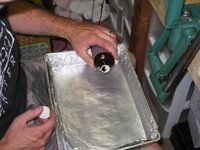

We use a side bench mounted neck lube brush that has a miniscule amount of Castor Oil on the bristles applied with fingers.

Resize and de-cap the primer, then...... remove the expander rod. Resize with a bushing die of the right diameter. We have a seperate press for each process, but if you don't you'll need to go through the sizing process twice, once with the Expander/De-capper and once with the bushing die. We use Redding Micro's for both processes.

A quick wipe.............
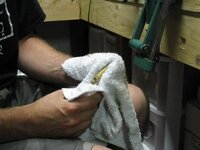
And on to the Wilson Trimmer. Use what works for you, but whatever it is, be certain that there is not one iota of variance case to case.
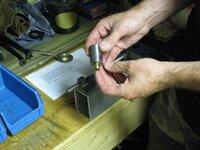
Continued
__________________
Continued
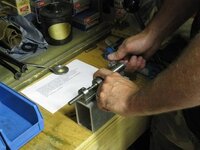
Ream and Champfer gently. There's no need to be aggressive with the brass.

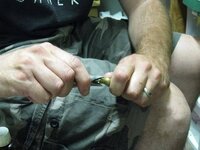
Insert primers. For this process we use the Forster and it's be dedicated to two processes, one of which is primer seating.
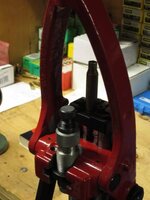
I've purposely ignored primer pocket truing and I'll explain why later.
For projectile seating we use the Redding Micro and that, for us, is critical.

We have electronics, but for precision reloading we use a very long I beam scale.
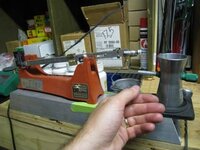
Next will come seat depths and primer pocket truing.
__________________
Latigo and P
An'' ole' Brer' Rabbit...... he set in de bushes..... he watch an' he wait... lay low an' he don' say nuffin'.
www.swissproductsusa.com
and.................. Projectile Prep
------------------------------------------------------------------------------------------
Anything out to 200 we won't necessarily do this, but beyond that range we would.
This is our process. Your's may vary, but this has proven itself for us.
Projectile prep:
We only use Berger VLDs, but Sierra SMKs work really great too.
Our method is to begin with meplat trimming. We use the Hoover. Buy the sort that indexes on the ogive, not the base of the bullet. That's going to be very important when you cross reference/compare actual seat depth from the ogive to COAL, cartridge to cartridge later.
Untrimmed
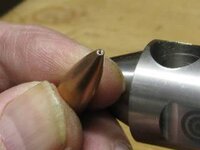
Trimming process.
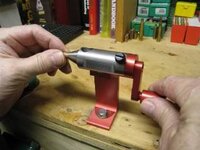
Trimmed
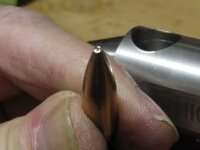
We then use a Hoover Pointer to reshape and center the hollow point and we taper it down to an opening that's approximately twice the thickness of the jacket wall.
Pointing
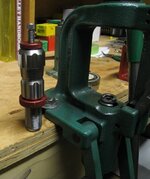
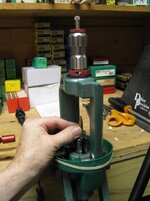
Pointed correctly

This is only the beginning of our overall case/projectile prep process.
__________________











